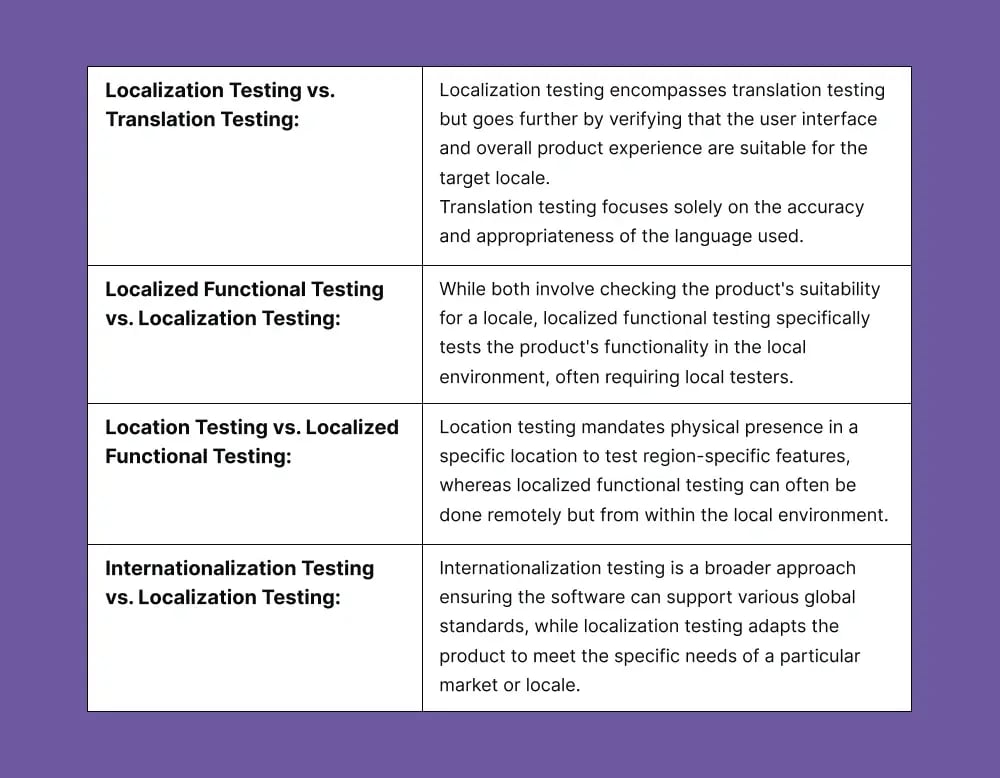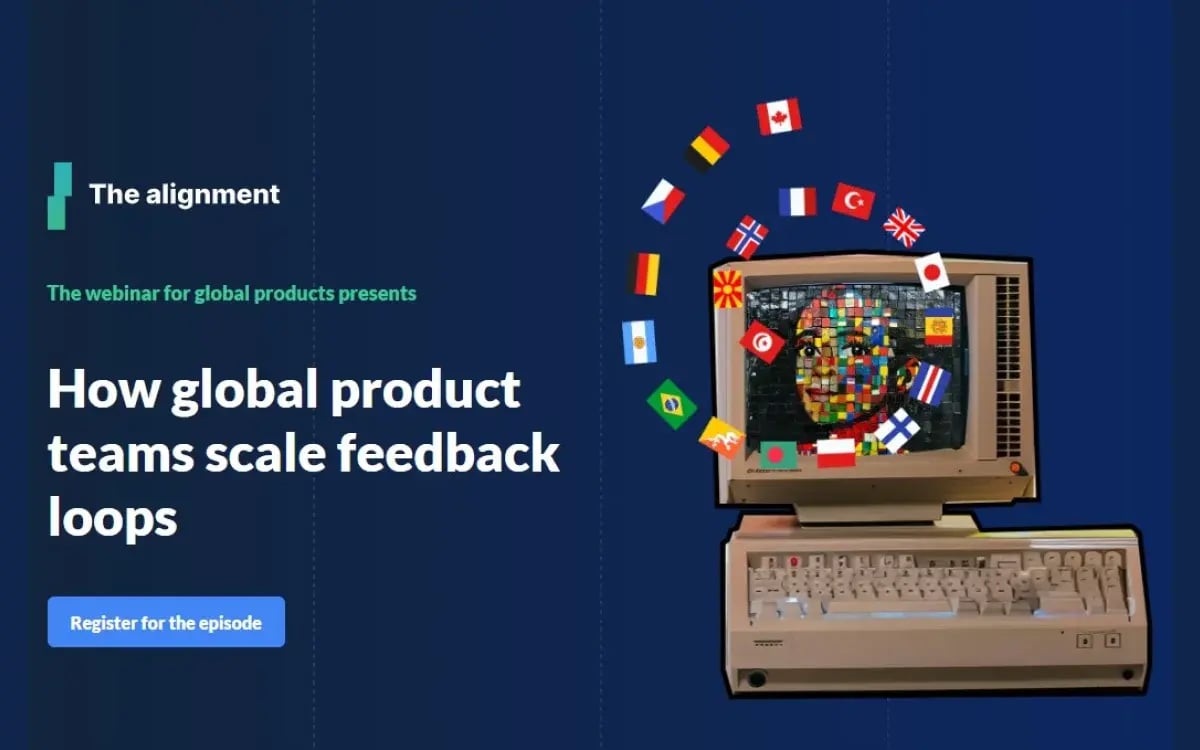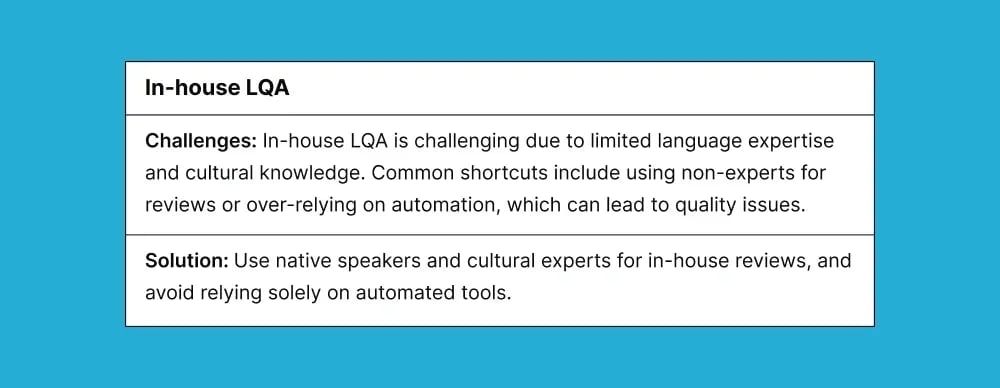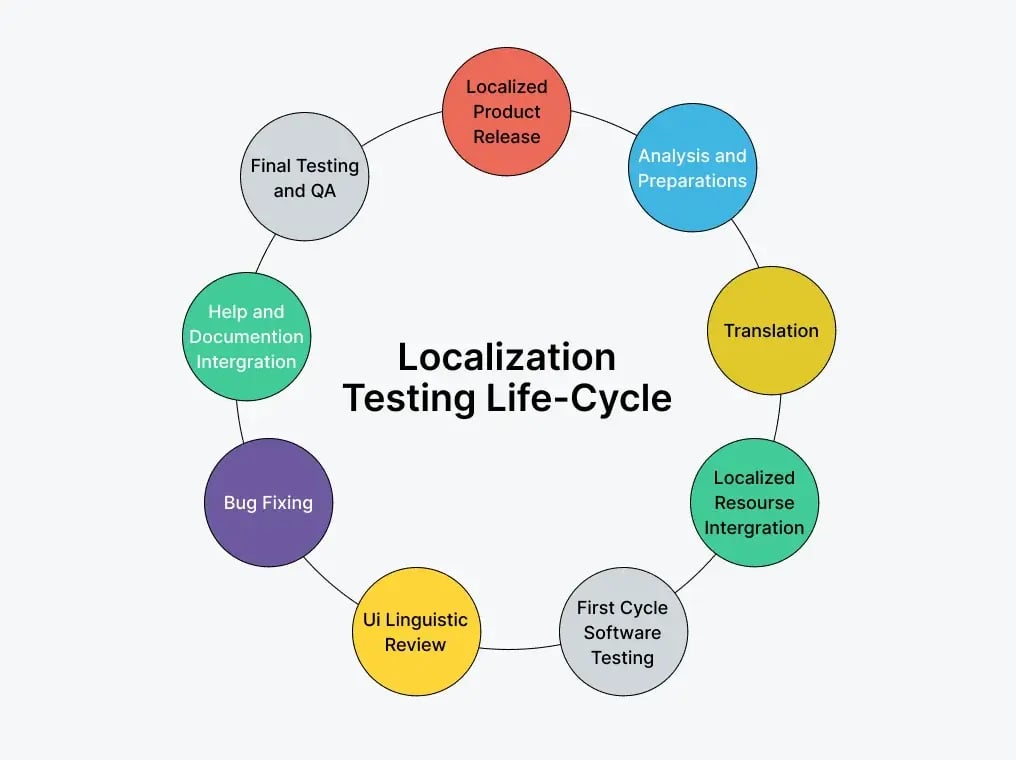-
How we help
- Does my software work?
- Does it work for all users?
- Global Growth Toolbox
- Industries
-
Platform
- Platform
- Integrations
- Browse all test types
- Add-on services
- Pricing
- Resources
Best practices for localization testing
Localization QA and localization testing are complex subjects, with an incredible degree of nuance and subtlety. This article will describe what “localization testing” can mean; and our best practices for how to undertake it in general. For details about l10n testing in its strategic context, check out our localization strategy playbook.

Imagine unlocking a new market with millions of potential customers, only to have your product fall flat because of cultural misunderstandings or functional missteps. Expanding your product internationally involves more than just translating words – it needs to align with the local culture, norms, and legal frameworks.
In this article, we’ll dive into localization testing best practices and see how it can transform your global expansion strategy. Are you ready to make your product a worldwide success? Let’s start!
What is localization testing?
Localization testing is the process of evaluating whether your product is suitable for a specific locale or region. This comprehensive approach ensures that the product resonates with local users linguistically, culturally, and functionally. We can categorize localization testing into two main areas:
1: Quality testing as part of a localized release cycle:
- Linguistic accuracy: Ensures all translations are contextually appropriate and error-free.
- Cultural relevance: Evaluates whether content, images, symbols, and color schemes are suitable for the target culture.
- Functional compatibility: Checks that features such as payment systems, date formats, and address fields work correctly in the local context.
- Legal compliance: Verifies that the product adheres to local laws and regulations.
2. Test-driven localization product strategy and changes:
- Opinion surveys: Gathers feedback from local users about their perceptions and experiences with the product.
- Factual testing: Conducts objective tests to assess the product’s performance, usability, and adherence to local standards.
- Blended appraisal: Combines subjective user opinions with objective test results to form a comprehensive evaluation of the localized product experience.
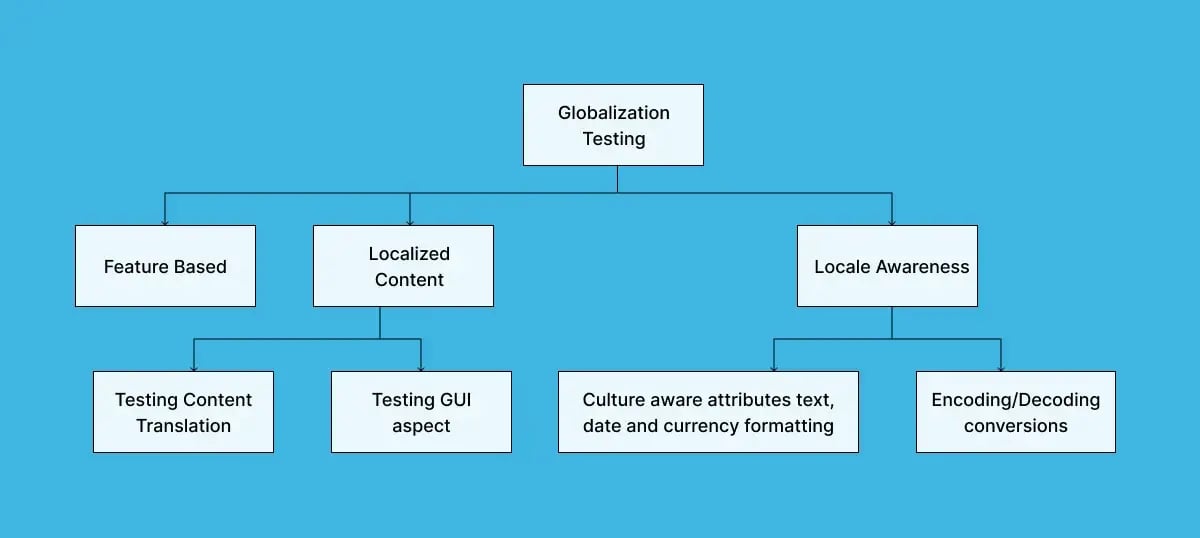
Many businesses use the term “localization testing” specifically to refer to testing the localized attributes of software. This involves determining whether the product changes are effective for local users, rather than simply verifying that the software functions properly. This specialized testing can include:
- Translation accuracy: Ensuring that all textual content is translated correctly and makes sense in the local language.
- Local user responses: Collecting feedback on how local users interact with and perceive the product.
- Usability and workflow: Ensuring that the product’s usability and workflows align with local user expectations and contexts.
- UI Issues and errors: Identifying and fixing user interface issues that may arise due to translations or cultural differences.
Even in its most basic form, localization testing is complex and requires a variety of testing techniques and approaches to get right. It involves:
- Automated Testing: Using tools to check for basic translation errors, missing text, and formatting issues.
- Manual Testing: Engaging native speakers and local users to provide feedback on cultural appropriateness and usability.
- Beta Testing: Releasing the product to a small group of local users to identify any remaining issues before a full launch.
- A/B Testing: Comparing different versions of the product to determine which is more effective in the local market.
Effective localization testing ensures that your product not only works technically but also connects meaningfully with local users, thereby increasing its chances of success in new markets.
Disambiguation: Understanding Localization Testing and related terms
When it comes to software and product development terms, jargon can often be confusing. To clarify, here’s how we differentiate between various types of testing at GAT:
1. Localization Testing:
- Definition: Ensures that a product is suitable for a specific locale or region.
- Example: Checking the accuracy of a Hindi translation with a Hindi speaker but conducting the test from California. This involves verifying the translation and ensuring that the user interface elements are appropriately adapted for the Hindi language.
2. Translation Testing (Linguistic Testing):
- Definition: A subset of localization testing focused specifically on verifying the accuracy and appropriateness of translations.
- Example: In the aforementioned Hindi example, this would involve ensuring that the translated text produced by your Language Service Provider (LSP) is accurate and contextually correct.
3. Localized Functional Testing:
- Definition: Functional testing performed from a particular country or region to ensure the product works correctly in a local context.
- Example: Testing an app's functionality using a phone in India operated by an Indian user to identify issues that only appear in the local environment.
4. Location Testing:
- Definition: Requires the tester to go to a specific location to conduct the test physically.
- Example: Testing a game with gambling elements that is legal only in certain states. To ensure it is accessible up to, but not beyond, state borders, a tester would need to be at the location physically.
5. Internationalization Testing:
- Definition: Verifies that the software can handle diverse global requirements in principle before specific localization is applied.
- Scope: Includes checking that the software can manage various character sets, date and time formats, and user interface layouts, such as those required for right-to-left (RTL) languages like Arabic.
Why localization is important – Key benefits
- Embracing global opportunities: Expanding into new countries opens up significant growth opportunities. Localization ensures your product is well-received in each new market, increasing your market share and revenue.
- Building in scalability: While initial localization testing can be time-consuming, establishing a robust process ensures faster and more efficient future releases. This allows you to quickly adapt to new markets as they emerge.
- Improving the testing process: A comprehensive localization testing process ensures that your product meets the highest standards, reducing the risk of linguistic or cultural errors that could alienate users.
- Engaging with customers: Localized products demonstrate a commitment to meeting the needs of local users, enhancing user satisfaction and loyalty. Customers are more likely to engage with products that feel tailored to their preferences and cultural context.
Best practices for localization quality within a release cycle
Effective localization is critical for ensuring that your product meets the expectations and preferences of users in various regions. Localization testing verifies that all aspects of the localized product are accurate, culturally appropriate, and functionally sound. Here’s a comprehensive guide on best practices for localization quality within a release cycle.
Pre-release QA focus
During the pre-release phase, the primary focus of localization testing is on the specific adaptations made for each locale. This includes ensuring that translations are accurate and culturally relevant and that the software functions correctly in the local context. Pre-release QA should address the following areas:
1. Translation accuracy and appropriateness:
- Example: When localizing an e-commerce website for the Japanese market, it’s crucial to not only translate product descriptions accurately but also ensure they reflect the local shopping culture and etiquette. For instance, using polite language and providing detailed product information aligns with Japanese consumer expectations.
- Best practice: Involve native speakers who understand local nuances and can review the translations for cultural and contextual accuracy.
You’ve probably seen numerous TikToks where people visiting Japan buy and try different flavors of famous chocolate bars. While the US page has a traditional and clean layout focusing on the candy itself, the Japanese version has a more artistic appeal that represents Japanese culture.

Even the box is specially designed to celebrate the Year of Dragon with a designated space where you can write a short message.

2. Functional Integrity:
- Example: A payment processing system might work perfectly in the U.S. but could face issues in Germany due to different banking protocols. Localization testing should verify that payment gateways, tax calculations, and shipping options function correctly in the localized version.
- Best practice: Simulate transactions and other critical functions using local settings to ensure everything works as intended.
Localization testing checklist
To ensure thorough localization quality assurance, test the following areas:
1. Language (Translation Testing):
- Scope: Verify the accuracy, completeness, and appropriateness of all textual elements, including user interfaces, error messages, menus, and dialog boxes.
- Example: In a multilingual application, a Spanish-speaking user should see error messages and notifications in Spanish, with correct grammar and context.
- Tools: Use linguistic QA tools and manual review by native speakers.
2. Formatting:
- Scope: Test the correct display of date formats, time formats, numbers, currency symbols, decimal separators, and other locale-specific formatting conventions.
- Example: A date displayed as "MM/DD/YYYY" in the U.S. should be "DD/MM/YYYY" in the UK, and currency symbols should reflect local usage (e.g., € for euros in Europe).
- Tools: Automated formatting check tools.
3. Cultural conventions:
- Scope: Ensure compliance with cultural norms, such as the correct representation of names, addresses, phone numbers, and postal codes.
- Example: In India, names are often displayed with the surname first. Addresses should follow local conventions, including area codes and state names.
- Tools: Cultural consulting and review by local experts.
4. User interface elements:
- Scope: Check the positioning, alignment, and appearance of UI elements like buttons, checkboxes, radio buttons, icons, and graphics for the specific locale.
- Example: In languages like Arabic, which are read right-to-left (RTL), UI elements should be mirrored appropriately to match the reading direction.
- Tools: Automated UI testing tools and manual inspections.
5. Input methods:
- Scope: Test the compatibility and functionality of various input methods specific to the target locale, including different keyboard layouts, character sets, and Input Method Editors (IMEs).
- Example: Ensure Chinese users can input characters using Pinyin or other local input methods without issues.
- Tools: Manual testing with different input devices and configurations.
6. Legal and regulatory compliance:
- Scope: Ensure the product complies with local laws and regulations, including privacy laws, labeling requirements, copyright notices, and disclaimers.
- Example: In Europe, your product must comply with GDPR regulations, requiring specific consent forms and data handling procedures.
- Tools: Legal consulting and compliance checklists.
7. Graphics and layout:
- Scope: Verify the correct display of localized graphics, images, icons, and other visual elements, ensuring there are no cultural or linguistic conflicts.
- Example: Avoid using images that may be culturally sensitive or offensive, such as certain hand gestures or attire. For example, Dota 2 changed their characters' names and appearance to be suitable for the Chinese market.
- Tools: Graphic review tools and cultural consulting.
8. Documentation and help:
- Scope: Test the accuracy, completeness, and consistency of localized documentation, user manuals, online help systems, and other support materials.
- Example: An online help system for French users should be translated into French and include region-specific FAQs and support contact information.
- Tools: Documentation review tools and manual checks by local experts.
9. Localization workflow:
- Scope: Evaluate the overall localization process, including the effectiveness of translation tools, version control systems, and project management systems.
- Example: Ensure that your Translation Management System (TMS) integrates seamlessly with your version control system to handle updates and changes efficiently.
- Tools: Translation Management Systems (TMS) and project management tools.
Further best practices for Localization Quality Assurance (LQA)
1. Split your quality and release streams
Different teams (commercial, product, engineering) have unique goals and requirements. Recognize these differences to tailor your QA process accordingly. Product teams may prioritize faster release cycles, while marketing teams might require thorough quality checks.
2. Avoid over-automating Localization Testing
While automation is valuable, localization testing involves nuanced evaluations like cultural relevance and naturalness, which often require human judgment. To maintain high quality, balance automation with human oversight.
At GAT, we have more than 90,000 testers in over 190 countries who can perform localization testing for any language pairing.
3. Prevent conflict of interest
Don’t let Language Service Providers (LSPs) evaluate their own translations. Independent review ensures unbiased quality assessment.
4. Improve release quality from the start
Develop a strong foundation for your localization process with clear documentation, quality culture, and strategic team choices. Check out our free webinar, The alignment, to learn more about localization strategies, best practices, and industry insights.
Localization testing services, tools, and fulfillment
Localization heads and managers take lots of different approaches to localization:
In-house LQA:
In-house Localization Quality Assurance (LQA) poses significant challenges due to the limited language expertise of even the most talented translators. Translators can only be fluent in a few languages and cannot be cultural experts in all regions. In smaller businesses, we often encounter shortcut techniques to verify translation quality. For example, they might ask a native speaker who is not a professional copy expert, such as an accountant who happens to be French, to review translations. This can result in subpar quality.
Another common issue is over-reliance on automated translation tools, which often produce poor-quality results and lead to user complaints. Although generative AI is expected to revolutionize translation and quality-checking processes in the near future, it still presents quality challenges that need to be addressed.
Localization testing services:
Global App Testing offers crowdtesting, an innovative approach to software testing that routes tests to real users around the world in the same way Uber would link you with a driver. The crowd provides a diverse pool of native speakers and cultural experts who can thoroughly test the localized content, identify linguistic and cultural issues, and validate the overall user experience. This approach allows for comprehensive testing across multiple locales, ensuring that the software meets the expectations and preferences of the target audience in different regions.

For example, a gaming company uses crowdtesting to verify that their game’s dialogues and user interactions resonate well with players in different countries. This approach is especially beneficial if it is a multilanguage game, like Uncharted, that offers no less than 20 languages, including Greek and Norwegian.
Localization Testing tools:
As we can already see, LLMs and AI tools will not only transform translation but are likely to transform LQA as well. Businesses should aim to automate their localization testing to the extent that it improves efficiency and accuracy without compromising the quality of the localized content.
Language consistency checks, text expansion validation, and formatting verification can be automated. Others, such as cultural adaptation and nuanced linguistic evaluation, continue to require human involvement. So, striking the right balance between automation and human expertise ensures faster turnaround times, reduces costs, and improves scalability.
Key takeaways
1. Automation and AI: Automation can improve efficiency and accuracy in areas like language consistency checks and formatting validation. However, cultural adaptation and nuanced linguistic evaluation still require human involvement.
- Example: Using automated tools to verify that all instances of a currency symbol have been correctly changed but relying on human testers to ensure cultural appropriateness in dialogues.
2. TMS and QA Tools: Translation Management Systems (TMS) with built-in QA functionalities help ensure translation quality and consistency.
- Example: A TMS that flags potential inconsistencies or untranslated segments for review by human translators.
3. Environment simulation: Tools that simulate different environments (e.g., version, language, time zone) help developers test software in conditions that closely mimic real-world use.
- Example: Simulating a Japanese user’s experience of a mobile app to ensure all localized elements function correctly in that specific environment.
If you want to learn more about choosing the best software for localization testing, check out our list of the best localization tools for your software.
Test-driven localization product strategy
The second category of localization testing is testing to build globalization data; i.e., to better understand your live product’s place in the market.
Test-driven localization product strategy leverages the invaluable insights gained from real users in their specific local contexts. By blending objective "functional" errors with usability questionnaires in real environments with local users, you can unlock a product strategy that puts a greater emphasis on the localization team and localization testing to deliver a better experience for local users.
Case study: How GAT helped resolve a critical payment issue for a French ecommerce business
An example of the effectiveness of GAT's testing methodology involves a major eCommerce business with significant operations in France. Initially, the business was satisfied with their product's performance in the French market. However, a closer investigation revealed a critical issue: MasterCard payments were failing on Android devices during checkout.
This bug had gone unnoticed amidst the complex metrics monitored by a single team responsible for overseeing European operations. The undetected issue was costing the business millions of pounds per month in lost revenue.
 By engaging local users through GAT's crowdtesting approach, the problem was quickly identified. Real testers using real devices pinpointed the MasterCard payment failure on Android phones. This localized testing allowed the business to resolve the issue promptly, leading to an enhanced user experience and significant improvement in business outcomes.
By engaging local users through GAT's crowdtesting approach, the problem was quickly identified. Real testers using real devices pinpointed the MasterCard payment failure on Android phones. This localized testing allowed the business to resolve the issue promptly, leading to an enhanced user experience and significant improvement in business outcomes.
Involving local users in the testing process identified and fixed a major issue and showed the importance of comprehensive, real-world testing to uncover hidden problems that can have a substantial financial impact.
How Global App Testing (GAT) can drive global growth
Global App Testing (GAT) offers a suite of testing solutions designed to drive global growth through quality assurance. Here's how we can help:
- Cross-comparative testing: At GAT, we employ a data-driven approach to analyze product performance across different regions. By comparing functional and UX testing results from high-performing and underperforming markets, we identify localization issues and provide actionable insights for your product teams. For example, we can help you understand why a product might excel in one country but not in another, leading to informed decisions such as adjusting character limits based on the superior performance of certain scripts.
- Intensive market-specific testing: We recommend focusing intensive testing efforts on key markets to achieve a stronghold. This approach is more cost-effective and can significantly boost market share. Through targeted testing and iterative product adjustments, GAT can help you enhance your Net Promoter Score (NPS) in specific markets. By doing so, you can drive exponential growth through positive word-of-mouth and create a dominant presence in crucial regions.
- Local market pulse checks: Our pulse checks provide a rapid and systematic way to integrate local UX research into your product development workflow. These proactive tests offer actionable insights from local users, elevating their feedback within your product organization. This ensures that global user voices are considered in design decisions, leading to better product adaptation and success in diverse markets.
If you're ready to enhance your global testing strategy, our experts are available to assist you. Sign up for a free demo to get started!
Keep learning
How to test WooCommerce checkout and payments
What is business continuity? (Plan, benefits, and software)
Generative AI testing: What it is and how to conduct it?
Choose a long term testing partner capable of supporting worldwide growth
Test in over 190+ countries and territories with a dedicated team used to testing specialized and enterprise applications.
Need some help with testing your product worldwide?
We’d love to give you a personal demo of our platform. Find out how we manage, execute and analyse functional test results to help you release high quality software anywhere in the world.

